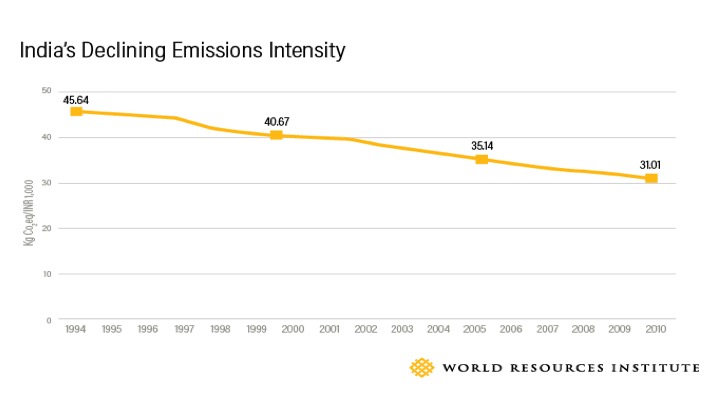India Can Meet Climate Goals and Sustain Economic Growth
by e -India has set out some of the world’s most ambitious renewable energy policies, including a target to ramp up solar installed capacity to 100 GW by 2022. Strong and clear policy signals, especially in the clean energy sector, demonstrate India’s leadership and continue to fuel optimism on sustained climate action. In 2015, India committed to reduce the emissions intensity of its GDP by 33 to 35 percent below 2005 levels by 2030.
New WRI research, Pathways for Meeting India’s Climate Goals, shows that the country can achieve this GHG mitigation goal through the existing policies we analysed, while maintaining annual GDP growth rate of 6 to 7 percent. By further enhancing 5 key policies and actions, the country can reduce the emissions intensity of its GDP by around 43 percent by 2030, relative to 2005 levels.

Five Key Policies
We analysed five key climate and energy policies and found that India will be able to meet its 2030 GHG mitigation target through their full and effective implementation. These policies include:
The Perform, Achieve, and Trade scheme, which is a domestic cap-and-trade scheme to incentivize energy-efficiency initiatives in energy-intensive sectors of the economy
Renewable power by 2022, which will see India increasing its renewable power capacity fivefold in seven years to 175 gigawatts by 2022
Dedicated Freight Corridor projects to expand India’s freight rail network
The clean environment cess— a tax on coal, lignite, and peat levied on domestically produced and imported coal with proceeds directed toward innovative projects that promote clean energy technologies (now expanded to other initiatives as well).
The Energy Conservation Building Code that sets minimum energy standards for commercial buildings above a threshold connected load and contract demand
The implementation of these policies will also deliver significant development benefits, such increasing household income, reducing air pollution, increasing jobs and creating new investments in environmental projects. For example, the study finds that these policies will increase income of rural and urban households in the range of 3 to 5 percent by 2030. This supports India’s overall approach to tackling climate change within the context of sustainable development.
Our study is underpinned by a model developed by KPMG India Private Limited. This model simulates the interactions among the economy, the energy systems, and the environment, and projects the GHG emissions for India until 2030 under different policy scenarios.
Achieving Ambitious Emissions Cuts Through Effective Policy Implementation
Our study finds that some of the key factors contributing to policy success in India include:
A diverse set of policy instruments, such as stimulus in Research & Development, manufacturing support, and financial support and subsidies.
Financial incentives, such as the bundling scheme under the National Solar Mission (where cheap unallocated power from central power stations is bundled for sale with more expensive solar power), or price reductions in energy efficient lightbulbs under the Affordable LEDs for All scheme.
Real-time monitoring of the implementation of policies, such as the online dashboards that track the distribution of energy efficient lightbulbs or the electrification of villages across the country.
However, some institutional, financial and technical challenges still need to be overcome, which include unexpected cost escalations, challenges in the enforcement of policy instruments and inadequate governance structures.
Looking ahead, the government agencies responsible for implementing India’s climate policies will have a critical role to play in overcoming these challenges and providing an enabling environment to ensure policy success. Capacity building—coupled with technology transfer and low-cost international finance—will be equally important for delivering India’s climate goals.


